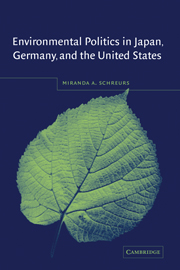Book contents
- Frontmatter
- Contents
- List of figures
- List of tables
- Acknowledgments
- List of abbreviations
- 1 Introduction
- 2 The birth of environmental movements and programs
- 3 The institutionalization of environmental movements
- 4 Acid rain: signs of policy divergence
- 5 Stratospheric ozone depletion
- 6 Global climate change: the road to UNCED
- 7 Global climate change: the battle over Kyoto
- 8 Global environmental politics and environmental policy communities
- 9 Domestic politics and the global environment: Japan, Germany, and the US compared
- Bibliography
- Index
2 - The birth of environmental movements and programs
Published online by Cambridge University Press: 22 September 2009
- Frontmatter
- Contents
- List of figures
- List of tables
- Acknowledgments
- List of abbreviations
- 1 Introduction
- 2 The birth of environmental movements and programs
- 3 The institutionalization of environmental movements
- 4 Acid rain: signs of policy divergence
- 5 Stratospheric ozone depletion
- 6 Global climate change: the road to UNCED
- 7 Global climate change: the battle over Kyoto
- 8 Global environmental politics and environmental policy communities
- 9 Domestic politics and the global environment: Japan, Germany, and the US compared
- Bibliography
- Index
Summary
This chapter provides a historical overview of the emergence of environmental programs in Japan, Germany, and the US. The beginnings of the modern environmental movements can be associated with the establishment of environmental administrations and the introduction of national pollution control legislation in the 1960s and 1970s. Until the 1960s, pollution control was perceived primarily as a local matter. Yet, the authority and capacity of local governments to act on their own to deal with pollution or to prevent environmental degradation was not well established. Development tended to take precedence over environmental protection at all levels of government. This slowly began to change as new environmental ideas challenged the status quo.
The rise of the modern environmental movement: the influence of the US
In the US, one of the most profound changes in modern times was the transformation of societal attitudes regarding pollution and environmental preservation that began in the 1960s. There were many voices that came together to alter the country's understanding of the relationship between humans and the natural world. Rachel Carson warned of the damage that agricultural chemicals were having on wildlife. Barry Commoner played an instrumental role in altering views regarding above ground testing of nuclear devices and the threat that some technologies posed to the earth's biological systems. Paul Ehrlich drew attention to the pressures of a growing population in his 1968 best seller, The Population Bomb.
- Type
- Chapter
- Information
- Publisher: Cambridge University PressPrint publication year: 2003

